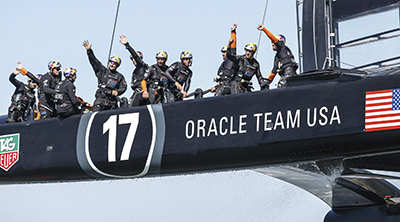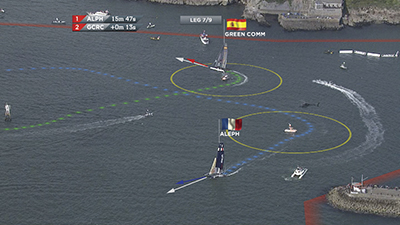Making Waves With Technology

Oracle Team USA celebrates their dramatic come-from-behind victory over Emirates Team New Zealand in the 34th America’s Cup last month.
SAN FRANCISCO—The creak, the groan, the water-weary faces—that’s what tells the story.
That was exactly the goal of the technology behind one of the most impressive comeback stories in sports history: to showcase the strain, the fear, the thrill of competing in the America’s Cup race on the chilly waters of San Francisco Bay.
But how do you get that from a yacht whipping across the choppy bay at 30 knots an hour, when every pound is accounted for, and no sailor in his right mind would simply let an engineer bolt a bulky camera onto the mast?
That was the problem faced by America’s Cup Television, SIS LIVE and NBC—which, along with NBC Sports Network, broadcast the final 13 days of racing from Sept. 7 to the exciting finale on Sept. 25—in their quest to cover the 34th America’s Cup race, a situation made tougher by other factors: Covering a sport that takes place entirely on water, and doing so in a way that keeps a viewer engaged to a sport that seems remote by comparison.
Success came from partnerships and technological innovations, according to Paul McNeil, head of the SIS LIVE special cameras team at SIS LIVE, a U.K.-based television production company. The first good news was the ability to bundle together the onboard cameras and the RF reception in a single box. Simple as it sounds, that was the first step in building a technology infrastructure that was streamlined and efficient.
The next successful innovation: working with an IP connection. Sportvision, the company handling graphics for the broadcast, relied on IP connectivity to communicate, “so all of the data that we wanted to control could go on their secure Wi-Fi network,” McNeil said. “That was a big plus,” he said, as compared to working in the more typical UHF or VHF setup. “That means that every operation we wanted to do on the boat— zoom, focus, color correction—was just [configurable] via an IP address,” he said, adding to increased efficiency.
Get the TV Tech Newsletter
The professional video industry's #1 source for news, trends and product and tech information. Sign up below.
At an event like the America’s Cup, sometimes real estate is the first big battle. “The hardest bit is getting your space on the boat or getting RF space,” he said.
The second: building solid relationships. “Because we were in on this process very early, nearly three years ago, that meant we could talk to the boat builders to make our equipment part of their boat,” McNeil said. Working in conjunction with the ship’s designers, SIS LIVE built specialized camera housing and mics directly into the holds and masts of the new carbon fiber sailing ships. “We were able to get cameras in places they couldn’t have otherwise been,” he said.
AC LIVELINE
The event resonated with TV audiences for another reason. One of the most talked-about technologies in the race was the AC LiveLine graphics technology, a real-time tracking system that embedded real-time graphics into the live broadcast.

The AC LiveLine graphics system triangulated the speed and path of the boats via an onboard telemetry system and camera system mounted to an overhead helicopter. The technology is a sister of the first augmented reality tracking system, devised by Sportvision in the mid 1990s for use on Fox Sports’ hockey coverage. The technology smacked into the path of sailing in 2010 when Oracle Co-founder Larry Ellison reached out to engineer Stan Honey to create a version for sailing. The result was “Live- Line,” a system that triangulated the speed and path of the boats via an onboard telemetry system and camera system mounted to an overhead helicopter. Boats could be tracked accurately up to 2 cm, Honey said.
Technology has a way of transforming things, even in the midst of a race. “After the race management group understood that we had that kind of accurate data, they asked me to take on development of the race management system, which used the same tracking and telemetry,” said Honey, director of technology for the America’s Cup organization.
“It was very rewarding, as the America’s Cup was very aggressive in using data to officiate the event. It was also frightening,” he added, knowing that this telemetry data was being judged down to the centimeter.
Engineering on the go They say necessity is the mother of invention. True, especially when water threatens to derail your broadcast.
When it came to devising a plan for keeping its cameras clean and dry, SIS LIVE did their homework. Engineers installed wipers on cameras, to keep them clear as the 131-foot yachts in the America’s Cup pounded their way through the choppy waters of the San Francisco Bay.
But what happened when the boats came to a stop, and were gently bobbing at rest? “We had wipers on agile cameras, but we foundthat when the racing stopped and [the commentators] began a live interview,there was a problem,” said Paul McNeil, head of the SIS LIVE special cameras team. “The commentators wanted to speak to the sailors, but because the boats were not racing, water was not splashing onto the lenses,” and that meant that the automatic wiping mechanism was not being triggered. The result: the lens sat there with random drops fogging up the shot.
The engineering team encountered this at the last World Series sailing race. In response, the SIS LIVE team created a small housing that sat underneath a camera, but because it was too late to run cabling, “we made a self contained cassette with a battery with circuitry, and when you switched it on, it did a magnetic field check,” McNeil said. On the camera they installed a small magnet, and using the Earth’s magnetic field, the wipers could be triggered to keep the lens clean.
“To be honest, we could have sat on the land, and said that’s that,” McNeil said. “But we found that you’d have a lovely shot, but it could be all misty. We were problem solvers. It all fell into place.”
Much like a hiking switchback, the technology displayed the racecourse clearly, allowing fans to more easily interpret what was going on.
“The LiveLine technology set clear boundaries for the entire course, displayed distance between boats and real-time wind, current and boat speeds,” said an NBC spokesman. “As a result, the technology complemented our announcers’ analysis, and allowed them to provide additional insight on each team’s actions and strategies. The combination gave viewers a true understanding of the excitement of America’s Cup racing.”
THROUGH THE SAILOR’S EYES
Across the event, the proliferation of technology was widespread—cameras were mounted to the yachts, helicopters, chase boats and on land. SIS LIVE installed six robotic HD cameras on each of the world’s fastest yachts—called the AC72— including on the 131-foot-tall mast and the 72-foot-long carbon fiber hull. A zoom on the robotic cameras allowed them to get into the emotions of the sailors on board. “Instead of cameras from shore or a helicopter, you’re actually in the boat in the field of play,” McNeil said. “We wanted to see what the actual sailors see.”
Sides are being taken on what was the most dramatic: such as when these boats tipped nearly vertical to the side, and the so-called “dolphin striker,” or the HD camera that was rigged under the boat, would lift up out of the water and give viewers a view of the yacht vaulting out the bay. “It told the story we wanted to tell completely,” McNeil said.
Or perhaps it was the sound. “Most of the emotion [from watching the race] came from the sound,” McNeil said. Five microphones were installed around the boat and on the crew: the henchman, the technical, the strategist, the jib trimmer and the wing trimmer. His favorite piece: the microphone strapped to the hull so you could hear the boat groan and “whump” through the waves.
Four broadcast images were packed into one RF stream that radiated from atop of the yacht’s mast to aerial arrays. That signal and the resultant 14 sound channels were packed onto an 8 MB channel and sent into a SIS LIVE production area before being pushed to NBC for branding and broadcast.
Yet despite all that technology, what was the biggest problem? “Water is always a problem; salt is a killer,” McNeil said, referring to the camera problems that plagued the last World Series sailing event.
Regardless, the race proved to be a thrilling one, with the trailing Oracle Team USA coming back from an 8 to 1 deficit to beat Emirates Team New Zealand. The technology can say the same, too. “We pushed the bounds of technology, and delivered it,” Mc- Neil said.
Susan Ashworth is the former editor of TV Technology. In addition to her work covering the broadcast television industry, she has served as editor of two housing finance magazines and written about topics as varied as education, radio, chess, music and sports. Outside of her life as a writer, she recently served as president of a local nonprofit organization supporting girls in baseball.

